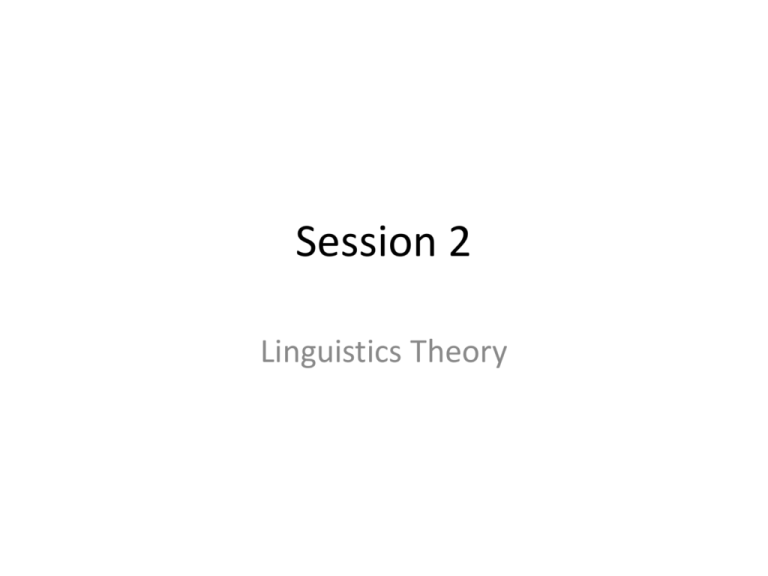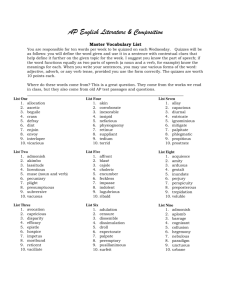Session 2 Part 1 - PRAXIS-Study
advertisement

Session 2 Linguistics Theory Objective 1: Understands phonetic transcription and terminology, stress and intonation patterns, and the effects of phonetic environment on pronunciation Phonology • The way in which speech sound patterns are formed. • Studies the organization and systems of sound within a particular language Phonetic Transcription • Uses the “International Phonetic Alphabet” to mark minute distinctions in sound and which places symbols in square brackets • It is a universal set of symbols to depict sounds, not spelling. IPA http://www.youtube.com/playlist?list=PLf5lHwZ mgnXzuV35GoDXAMXArtvkE4VrU IPA Let’s Practice /kæt/ / kʌp / / ʃʊk / Voiced/Voiceless • In the first two rows of the consonant half of the chart, notice that the sounds are paired. There are voiceless on the left (p) then the voiced (b) • Unvoiced- your vocal cords do not move or buzz when speaking a sound • Voiced- your vocal cords “buzz” when speaking a sound Place of Articulation • Where the sound is formed in your mouth Bilabial /b, p, m/ Bilabial Alveolar /d, t, z, s, n/ Alveolar Labiodental /f, v/ (f as in fan or v as in van) Labiodental. Velar /k, g, ŋ / ( k as in cat, g as in great, ŋ as in bring: Velar Manner of Articulation • How the sound is formed in your mouth Fricatives Fricatives are consonants that are formed by impeding the flow of air somewhere in the vocal apparatus so that a friction-sound is produced. 1. /f/ (the phoneme spelled f in fine): voiceless labiodental fricative. 2. /ð/ (the phoneme spelled th in this): voiced interdental fricative 3. /z/ (the phoneme spelled z in zoo): voiced alveolar fricative. Plosives Plosives are speech sounds produced by complete closure of the oral passage and subsequent release accompanied by a burst of air, as in the sound (p) in pit or (d) in dog. 1. /t/ (the phoneme spelled t as in time): voiceless plosive. 2. /d/ (the phoneme spelled d in dog): voiced plosive. Phonemes The smallest unit of sound that affects meaning, i.e., to distinguish between two words In English there are 44 speech sounds, but only 26 letters. ten, ton, tan, tin Stress and Intonation Patterns • Pitch it determines the context or meaning of words or a series of words. The difference between “I can’t go,” and “I can’t go?” • Stress can occur at sentence or word level. The stress of the syllables can affect meaning. CONflict ( a noun) versus conFLICT ( a verb) Phonographemic Differences between words of English that are a common source of confusion and thus need to be taught explicitly Homonyms- Word forms that have two or more meanings, i.e., can (to be able) and can (a container) Homographs-Two or more words that have the same spelling and pronunciation but different meanings, i.e., stalk (part of a plant and stalk (to follow) Homophones- Two or more words that have the same pronunciation but different meanings and spelling, i.e., would/wood, cite/sight Heteronyms- Two or more words that have the same spelling but have a different pronunciation and meaning, i.e., Polish/polish Sample questions • Which word do you hear when I say ______? A. B. C. D. • [kut] [kæt] [cət] [cæʄ] How would native English speakers more than likely pronounce the word “laughed” A. B. C. D. [lətId] [left] [læft] [loft] Objective 2: Knows the various types of morphemes and understands how words are morphologically related to each other Morpheme • The smallest meaningful unit in the grammar of a language. Includes all root-words, prefix, suffix and s within the context of the word. • Examples: – Unladylike: The word unladylike consists of three morphemes (un – lady – like) • None of these morphemes can be broken up any more without losing all sense of meaning. Lady cannot be broken up into "la" and "dy," even though "la" and "dy" are separate syllables. Note that each syllable has no meaning on its own. – Dogs: The word dogs consists of two morphemes (dog – s) /s/ is a plural marker on nouns • Note that a morpheme like "-s" can just be a single phoneme and does not have to be a whole syllable. – Technique: The word technique consists of only one morpheme Morphemes http://www.youtube.com/playlist?list=PLf5lHwZ mgnXzuV35GoDXAMXArtvkE4VrU Morphemes • Root or base word- the key to understanding a word, because this is where the actual meaning is determined “happy” • Prefix- the syllable that appears in front of the root or base word and can alter the meaning “un” • Suffix- letter or letters that are added to the end of a word and can alter tense and/or meaning of the root or base word “ness” Unhappiness Bound Morpheme • Must be attached to a root word to have full meaning (affixes – i.e., prefixes and suffixes) – Example: /un/ means not. /un/ has no meaning unless it is attached to a root word. • Unthinkable – /un/ (bound morpheme) – think (free morpheme) – /able/ (bound morpheme) Free Morpheme • Units of a word that can stand alone as words themselves. Derivational Morphemes • Affixes (prefixes and suffixes) that can be added to a word to change its meaning and may also change its part of speech – Examples: • • • • • amaze (verb) > amazement (noun) speak (verb) > speaker (noun) Perform (verb) > performance (noun) soft (adjective) > softness (noun) warm (adjective) > warmth (noun) Inflectional Morphemes • Affixes (prefixes or suffixes) that can be added to a word without changing its part of speech. • They simply change the inflection of a word. For example…changing “teacher” to “teachers” adds the morpheme “s”, but it still remains a noun. Inflection • A grammatical form of the word. In English, all inflections are suffixes and occur at the very end of the word. • English verbs are inflected for mood, tense, person and number (run, running) • Nouns and adjectives are inflected for plurality and possession (teacher, teachers) • Adjectives are inflected for comparatives and superlatives (pretty, prettier, prettiest) Morphemic Analysis • Grammatical words- of, the, and, which, but, so, some. Rarely borrowed from other languages or invented. • Lexical words- constantly borrowed or invented (google) Objective 3: Knows the basic features of English syntax (e.g., how words are combined into phrases and sentences and transformations such as question formation) Syntax - Grammar • Governs the form or structure of a language; the way words are put together in a language to form phrases, clauses, or sentences. • The syntax of a language can be divided into two parts: – Syntactic classes such as noun, verb, and adjective – Syntactic functions, such as subject and object Examples of English Syntax “show” • That TV show was boring. (Noun) • I will show you my new dress. (Verb) • The band plays show tunes at half time. (Adjective) The Eight parts of Speech • • • • • • • • Noun Verb Pronoun Adjective Adverb Preposition Interjection Conjunction Degrees of Adjectives Base Comparative Superlative High Higher Highest Thick Thicker Thickest Beautiful More Beautiful Most Beautiful Bad Worse Worst Verb tense • Present • Past • Future Active Verb Tense Verb Tenses Simple Progressive Perfect Perfect Progressive Present I write I am writing I have written I have been writing Past I wrote I was writing I had written I had been writing Future I will write I will be writing I will have written I will have been writing Types of Pronouns Personal Relative Indefinite Demonstrative Interrogative reflexive I, me, mine you, your, yours he, him, his she, her, hers It, its, who, whom, whose we, us, ours they, them, theirs Who, whom, whoever, that, which all, another, any, anyone, anything, everyone, everything, each, both, neither, no one, none someone, something, few, some, many, most, several this that these those who whom which what Whose myself yourself himself herself itself ourselves Yourselves themselves I will cook dinner myself. Ends in -self or -selves and refers back to another noun or pronoun in the sentence It is mine. Takes the place of a person, place or thing The chef who won the prize studied in Paris. Introduces a relative clause and links to another part of the sentence. Everyone came to dinner. That car is the one I want. Who is the author of that book? Refers to an unknown person, place or thing Represents a thing or things Used to ask questions Sentences • Parts of a Sentence – Subject- The topic of a sentence consists of a noun or pronoun and all the words that modify it. “The snow” – Predicate- Makes a statement or a comment about the subject and consist of all the verbs and the words that modify it. “falls quietly.” The snow falls quietly. – Compound subject- Two or more subjects – Compound predicate- Two or more predicates Sentence Types – Simple- A complete thought consisting of a subject and a predicate. • The bus was late. – Compound- Two independent clauses joined by a coordinator (and, or, nor, but, for, yet, so) • Tom walked to the bus station, and he took the bus. – Complex- Consists of dependent clause (not a complete thought) and independent clause joined by using a subordinator (although, after, when, because, since, while) • After I write the report, I will submit it to my teacher. Sentence Purpose – Declarative: Makes a statement: “Anna will feed the dog.” – Interrogative: Asks a question: “Anna, have you fed the dog?” – Imperative: Gives a command: “Anna, please feed the dog.” – Exclamatory: Expresses a sense of urgency: “Anna, go feed the dog right now!” Sentence Transformations • Yes/No questions: Sentences may be transformed into yes/no questions. (auxiliary verb + subject + main verb + rest of sentence:) – He lives in Chicago. Does he live in Chicago? • Information questions: Sentences may be transformed into information questions. (question word + auxiliary verb + subject + main verb + rest of sentence.) – Susan lives near Orlando. Where does Susan live? • Active Voice to Passive Voice or vice versa: Sentences may be changed from one voice to another voice. – I saw John. John was seen by me. John was being helped by me. I was helping John. More Sentence Transformations • Indirect Objects: The word “to” (phrase marker) may be deleted. – I gave a cookie to him. I gave him a cookie. • Imperatives: The imperative or commands have no expressed subject. – You sit. You jump. Sit! Jump! • Negatives: Linguists distinguish between two types of negation: – Affirmative sentences may be transformed into negative sentences where the whole sentence is negative. • Marion is happy. Marion is not happy. – Parts of sentences may be negative. • Juliana is happy. Juliana is unhappy. Objective 4: Basic features of semantics and how combinations of words convey meaning Semantics • The branch of linguistics concerned with meaning. • The meaning of a sentence (or phrase) is usually assumed to be derived from the words in a sentence, but meaning is often derived from the who sentence and its context. Presupposition • Speech that is not spoken, but nevertheless, understood by the speaker. – “The Headquarters of the American Orchid Society of American is located in Delray Beach, Florida” – Presupposes that there is an American Orchid Society Implication • Concerns implications the listener can make from utterances without actually being told. – I tried to send an email to the director. – Implies that for some reason I was unsuccessful Prosodic Features • Use of stress and tone to convey meaning – Jonathan visited Miriam • Visited Miriam and no one else. Idioms • Very difficult for English Language Learners because their meaning is figurative, not literal. • Best studied in context, not isolation. • Compose a book of the literal and figurative meanings. • The ball is in his court.








